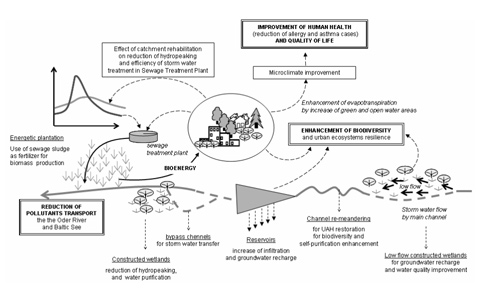|
|
Ecohydrology for Urban Aquatic Habitats From the point of view of environmental science, urban environment can be considered as a highly condensed anthropogenic system, which is organised for efficient flow of water, matter, energy and information. This extremely productive "organism" can efficiently provide the services required by the society such as safe drinking water and efficient sewerage, which is very important due to very high population density. However, increase of society's education and environmental awareness rises also the public demand for improvement of the quality of life. Therefore other expectations, depending to a great extent on proper ecosystem functioning, appear. These include ecosystem services such as those determining human safety (e.g., mitigation of floods), health (e.g., water quality improvement by self-purification, clean air), as well as those fulfilling materialistic and spiritual aspirations - high quality living space, recreational areas and aesthetic values. The services depend to a great extent on the functioning of aquatic ecosystems and their ability to cope with high impacts, determined among others by the size and distribution of "green areas". However low availability and high prices of land in cites make maximising environmental amenities at low management a real challenge for any society. Therefore one of the alternative solutions is increasing the absorbing capacity of ecosystems, in order to improve their ability for coping with the highly condensed human impacts in urban areas. The methods for achieving this are implicitly provided by the main principle of ecohydrology (Zalewski et al., 1997), which postulates to "use ecosystem properties as a management tool" for enhancement the efficiency of some regulatory processes. The solutions have to be synergistically integrated into the city "system" by their harmonisation with engineering solutions. Ecohydrology is a scientific concept, which quantifies and explains relationships between hydrological processes and biotic dynamics at a catchment scale, and is applied to solving environmental problems (e.g., Zalewski 2006). It has been defined as a sub-discipline of hydrology focused on ecological aspects of the water cycle. This concept is based upon the assumption that sustainable development of water resources is dependent on the ability to restore and maintain the evolutionarily established processes of water and nutrient circulation and energy flows at the catchment scale. Ecohydrology for the urban environment The expression a "green city" is synonymous with the notion of a healthy urban environment with a high quality of life. Moreover, it implicitly means that a significant part of the urbanised space is covered by semi-natural terrestrial and aquatic ecosystems. Freshwater and terrestrial ecosystems have an excellent potential for moderation and control of the water cycle and pollution that should be considered while management plans are being developed. Such areas in cities provide citizens not only with regulatory ecosystem services, but also aesthetic, cultural and recreational values. However first and foremost improve human health in direct and indirect ways. There is growing evidence that higher and more stable moisture of the city air reduces the amount of dust which in turn reduces asthma, allergies and other related diseases. Also the opportunities for recreation in green areas are important for the proper physical and psychological regeneration of inhabitants. Rehabilitation of a municipal river: an example of possible multidimensional benefits for the urban environment and the society Well-managed water habitats are visually the most attractive elements of modern cities landscapes, and are usually considered by city planners as "axes" or "nucleii" around which individual green areas and urbanised spaces are functionally organised (e.g., Day et al., 2005; Tezer, 2005; Braioni et al., 2006). They improve the quality of life and human health and accelerate the city development, by attracting creative and innovative leaders. Resources:
|
||||||||||

